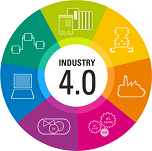
Industry 4.0: Faster, smarter, and more collaborative methods
As originally used in its first edition by the Industry platform at the 2011 Hannover Fair (http://www.plattform-i40.de/)
“INDUSTRY 4.0 represents a technological evolution from embedded systems to cyber-physical systems.”
Throughout history, there have been four major industrial revolutions.
- 1. The advent of machines powered by water and steam
- 2. The introduction of electric machines and the concept of production line logic
- 3. Industrial Automation
- 4. Transition to Cyber-Physical Systems
Industry 4.0 primarily aims to merge Information Technologies with Industry. One of its key components is Next-Generation Software and Hardware, targeting hardware that differs from today's traditional equipment by being low-cost, space-efficient, energy-efficient, heat-efficient, yet equally reliable. It also aims for operating and software systems to be frugal in terms of resource and memory usage. The second and perhaps most important component is the Device-based Internet (Internet of Things), where all devices on Earth are interconnected for information and data exchange. This involves integrating all kinds of tools with sensors and processors, forming Internet-connected smart electronic systems, also known as Cyber-Physical Systems. The use of cyber-physical systems in manufacturing means 'smart factories' capable of coordinating and optimizing production nearly independently of humans. If the Industry 4.0 strategy is realized, production time, costs, and the amount of energy needed for production will decrease, while production quantity and quality will increase.